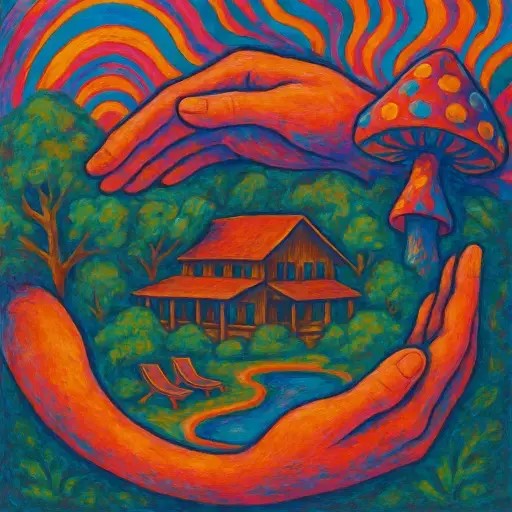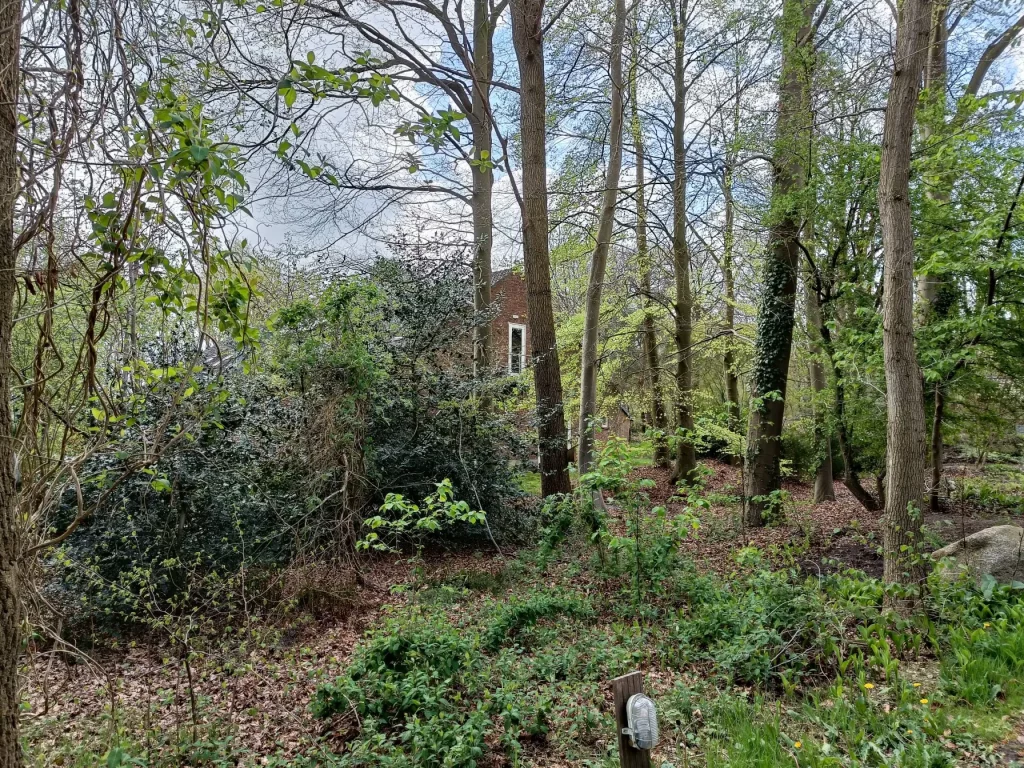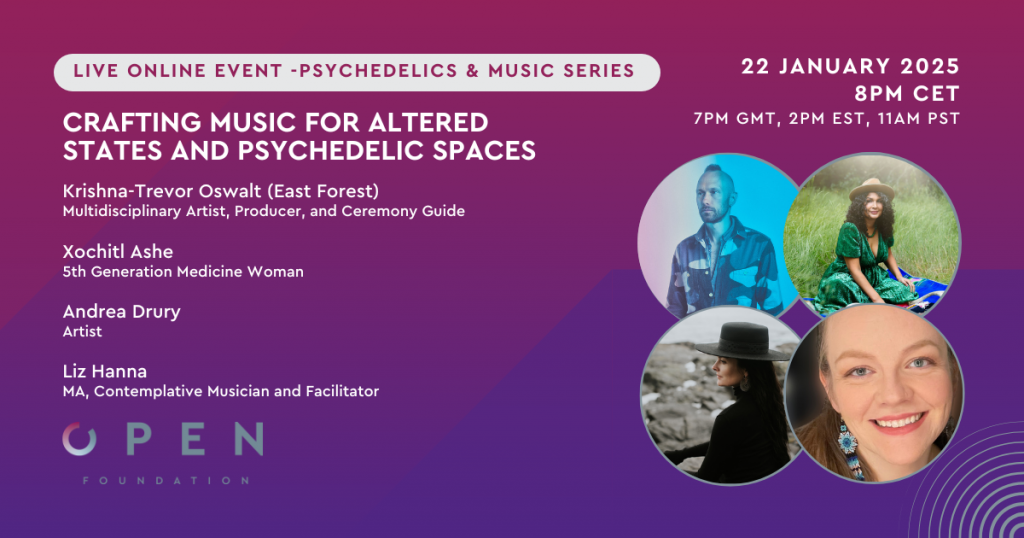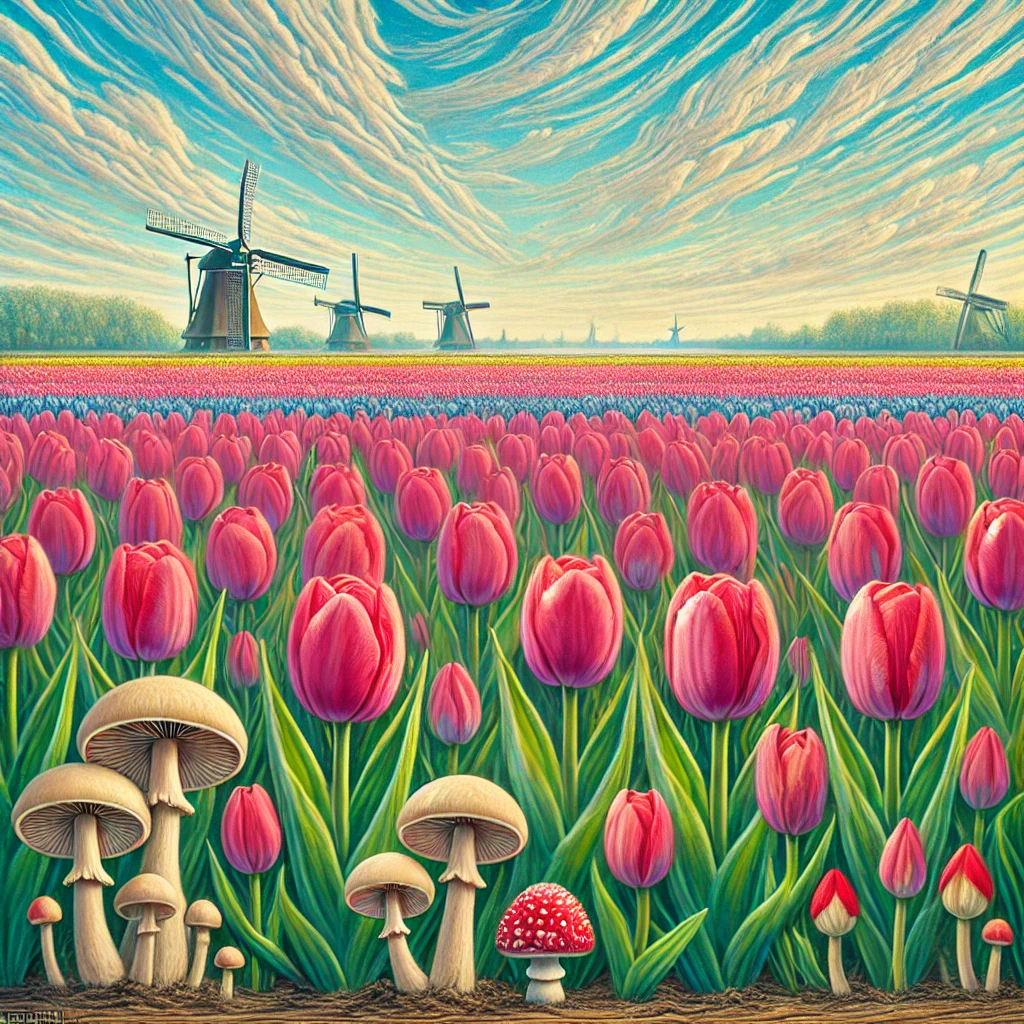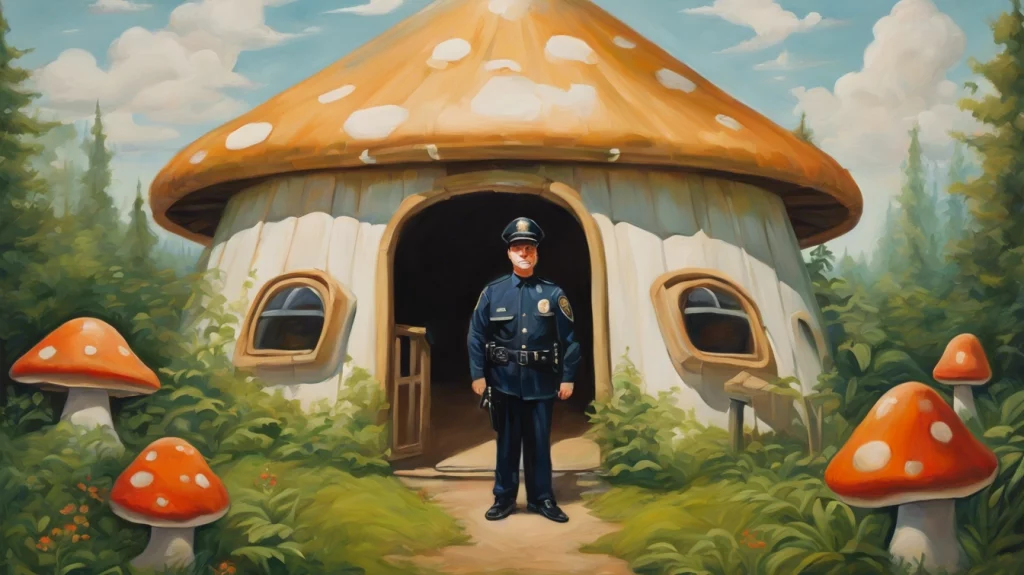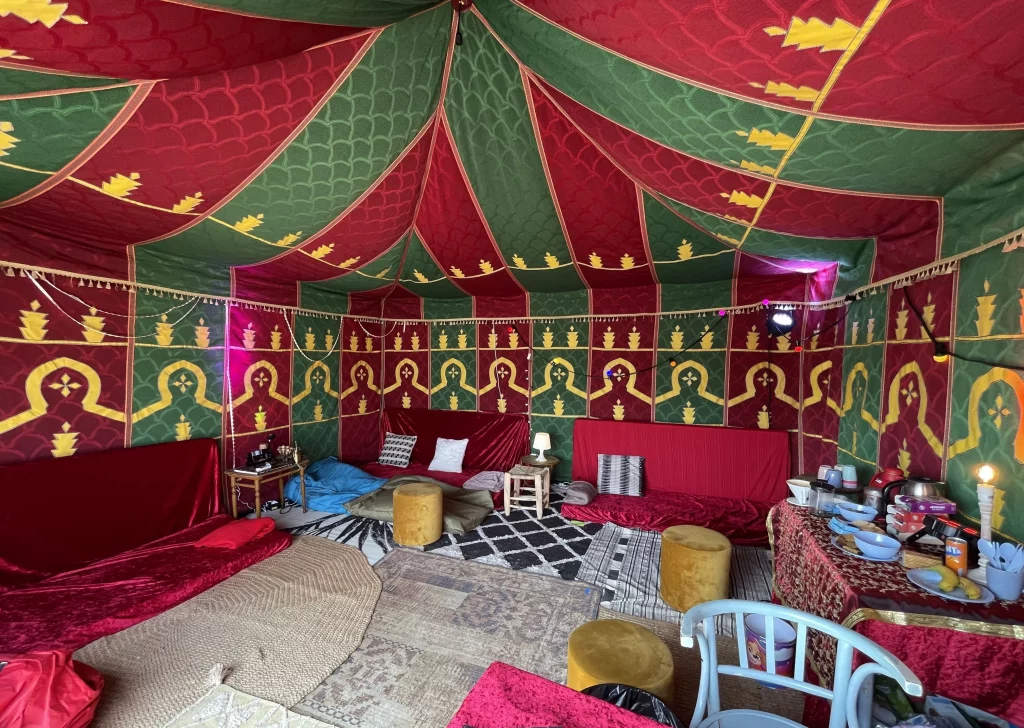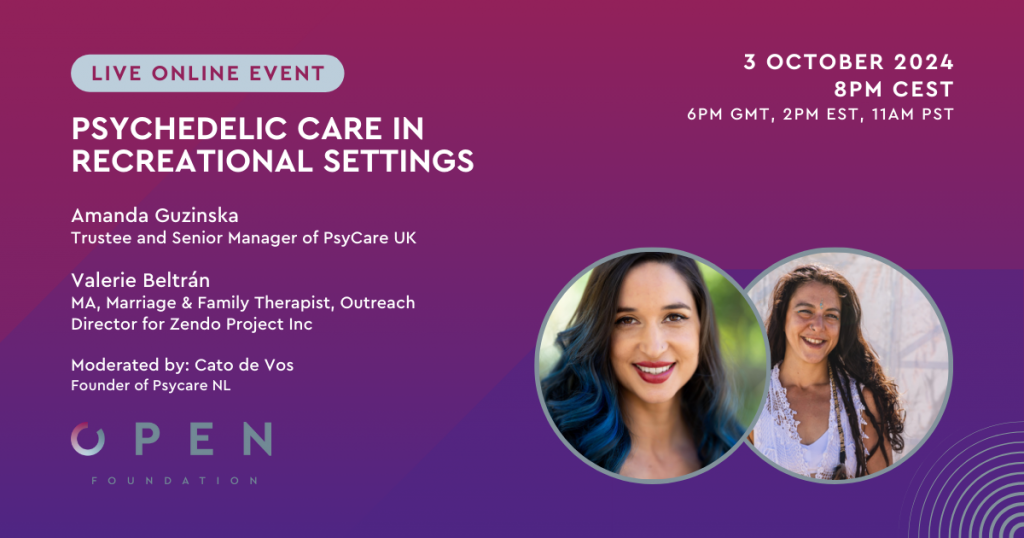Safe and Beneficial Psychedelic Experiences – From the Field
From the Field: Lessons from psychedelic practices in the Netherlands is a blog series based on my qualitative research at the Rijksuniversiteit Groningen in collaboration with the OPEN Foundation. The study focused on the conception and practice of safe and beneficial use of psychedelics in group settings in the Netherlands: more specifically in counterculture, ayahuasca ceremonies and truffle retreat centers. Based on in-depth interviews with experienced practitioners, the series highlights and connects diverse aspects of psychedelic practices, from cultural influences through ethics to sensory stimuli. This post dives deep into participants’ autonomy.
Part 1: Lessons on Psychedelic Harm Reduction with PsyCare NL – From the field
Part 2: Dutch Psychedelic Practices Shaped by Culture and Law
Part 3: From the Field: Music in Psychedelic Practices
Part 4: From the Field: Psychedelics and Nature
Part 5: From the Field: Psychedelics and Autonomy
Part 6: From the field: Safe and Beneficial Experiences (current post)
As this series comes to an end, I return to my initial research questions: which group practices exist around the use of psychedelics in the Netherlands (Q1); and how do facilitators envision and practice their safe and beneficial use? (Q2).
To answer the first question, a survey was sent to the members of OPEN (n=112), inquiring about psychedelic practices they know and how they can be classified. Yet due to legal constraints, data collected via the survey was mostly too vague or anecdotal to draw a map with. Leaving the question unanswered was a source of frustration. Over time, watching developments in the so-called psychedelic renaissance, and remembering the tragic consequences of the popularization of psychedelics for María Sabina, my frustration subsided. At this point in time, it seems to me that there are good reasons for some practices to remain underground. Luckily, they are not buried very deep, allowing relatively easy access for interested individuals.
The interviews for the second question brought some interesting and unpredictable answers. The roles which music, nature, autonomy and dosing play in creating safe and beneficial spaces were discussed in detail. In this concluding article, I will focus on the general approach or mindset of facilitators, and how it binds the different pieces together into a safe and beneficial whole.
Care, responsibility and trust in psychedelic practices
Joost Breeksema, the director of OPEN, wrote ten propositions on the basis of his dissertation Exploring Inner Depths, a qualitative research of patients’ lived experiences with psychedelic treatments for depression. At least two of them concerned relationships between clinicians and patients, mirroring each other. On the positive side, he posited that “trust and substantial time investment from clinical staff” are required for patients to let go of control, which is key for success. On the negative side, another proposition was that “treating ketamine as a pharmacological antidepressant likely causes patients to be under-treated, inadequately supported, and possibly even harmed”. Thus according to patients, unquantifiable elements like care, responsibility and trust cannot be removed from the healing equation. How are these aspects expressed, and how do they contribute to safe and beneficial experiences in psychedelic practices? Before the complicated answers blur the picture, here is Anton’s simple and straightforward explanation: common sense. “We really take good care of people, treat them as human, and treat them as they’re welcome and they are our guests.”
This general attitude is similar with other facilitators, but specific modalities and interventions depend on the type of practice, personal knowledge and preferences of the facilitator. The specific balance between care, responsibility and trust also differs between facilitators, giving each practice its special character. When people have challenging experiences, Albert the shaman treats them according to shamanic healing practices. Cultural events organiser Chris explained that during a festival “someone [would invite them] into their space, lay them on the couch, bring them a cup of tea and then calm them down.” In Anna’s ayahuasca ceremonies, “as a team, we’ve learned to really stay grounded, to use your voice, and sometimes touch and to really connect with people. You let them know we’re here, and it’s gonna pass; and we won’t leave you alone, a lot of times that’s also an important one”.
Establishing trust
Interestingly, it appears that the underground nature of psychedelic use in counterculture and ayahuasca ceremonies helps in keeping these spaces safe. New participants are mostly introduced via former ones. In the case of countercultural events, Carla explained that “you have to come here a first time to figure out that these kinds of things are possible, and that you’re not being checked [by security] when you come in, that nobody is going to go through your pockets to see if you brought something naughty”. Anton tells participants that they may share their experiences from ayahuasca ceremonies with interested people, but should not convince them into the process. Thus, ideally people who are not a good fit or are not ready will not be introduced, and those who will, would already have some prior information about the practice. This can be seen as a sort of pre-selection of participants, not by the facilitators but by the relevant community.
As Rob explained, feeling safe and welcome begins with people’s first impression. During their first phone call to the office of the retreat centre, a potential customer can already feel that the people on the line “are very well informed and know what the work is about, even though they’re not facilitating… Really being heard and seen through that call, I guess, is the first experience for people to feel comfortable working or doing an experience with our organization.”
Preparation for ceremony
The preparatory phase in ceremonial practices begins with screening potential participants through intake forms. Their length and thoroughness differ, but they all include questions about one’s personal life, physical and mental condition, including past traumas and the use of medication. In most practices, personal intake conversations and group meetings follow. These help in further screening of people who may not be a good fit for the practice. Ronald marked this as a potential friction point, “because some businesses are set up in a way that they need to work with a certain number of clients a month, and they might be forced to say yes from an economic point of view”. Being able to refuse certain customers is a form of caring, just like being friendly or offering healthy organic food. Most facilitators feel that in such a case they should offer alternatives, “otherwise, they just go to another provider that will say yes”, Anna clarified. For example, when she meets young people who have not done any personal development work, she often refers them to another practice, like breathwork. Anton sometimes lets people who are not a very good fit participate with a microdose.
A week before the ceremony, an online preparation workshop is organized by the retreat centre. It consists of an introduction of participants and facilitators “to establish a sense of familiarity and trust”, Ronald explained. Expectations are set and practices that will be used during the retreat, such as breathwork and meditation, are introduced. Discussions between the staff help at comparing impressions and identifying participants who might need extra attention during the retreat. According to Rob, sometimes the workshop exposes further reasons for screening, for example when someone shares recent life events that make it “not the best timing” for a psychedelic experience. Next to the workshop, a WhatsApp group is created and stays open indefinitely. Guides and participants can all contact each other easily.
In all ceremonial practices in my research, participants are supplied with an abundance of information about the relevant substance(s), the flow of the ceremony, best practices and risks, as well as practical details about the space, sleeping arrangements and so forth. Anton’s quote demonstrates how care and responsibility are woven into the most practical instructions: “if you can’t clean your bucket – don’t bother, we will do it for you. But we really invite you, when possible, to do it yourself; it’s a kind of finishing your process… And we have a special room for if it’s too noisy here; you can go there, and we check on you regularly.” Detailing everything which is going to happen helps participants “feel safe on a mental level and to feel prepared”, Ronald clarified. Facilitators explain that participants, especially non-experienced ones and people who have had issues with safety and trust, are usually nervous and sometimes even anxious before the ceremony. “Most people, when they come, they have so many guards up, because they don’t know the team, the place is unfamiliar, they don’t know what you’re doing.” Thus, Anna explains, the preparation process helps make space for those feelings, and “it’s almost like step by step, you take them by the hand and their nervous system can relax”.
Some practitioners have an agreement, which is discussed and signed by the staff and participants. Ronald explains that these “bonds of trust are a container and mutual understanding of how the time together will look like.” Anna also stressed some reciprocal aspects of the agreement and the ceremony as a whole. For example, her agreement states that participants should “listen to us when they’re in ceremony”, but it also “makes a promise that we as a team, will handle it.” During sharing circles, not only participants share their intentions and feelings, but “we as a team also share, so we’re also part of the circle”.
In addition to sharing circles, preparation often includes activities for getting familiarized with subtler altered states through various techniques, like meditation and somatic practices. Yet it seems that trust is built first and foremost through the team’s presence and the setting itself. Rob describes the retreat location as “a beautiful comfortable space, where people don’t need to worry about anything. Everything is taken care of, nice materials, fabrics, food”. It is a setting where “everything fits together, because that also establishes a sense of trust, and a sense of: they take care of every detail so they will also take good care of me”, Ronald traced the subconscious connections between setting and set. Similarly, he explained, the guides’ way of showing up makes participants “feel safe to open up”. Thus, while specific interventions may serve as inspiration for future applications, it seems that an intuitive, sometimes unconscious interplay between place and people is the secret ingredient of all practices. Anna noticed this with new participants: “sometimes I’m still surprised. They come in… they say, ‘I feel so at home here. I feel so welcome. I feel so… somehow so safe’. And I’m like, ‘we haven’t even started yet’.” Rob referred to this same quality: “I can make people feel safe quite fast by just being myself and not trying to impose ideas on them or trying to change someone.” When I asked him why he was equipped for this job, he said: “I truly care for other people. I think that is the most important quality to have as a facilitator, that you actually care about the people that you work with and also care about the work in a broader sense.”
Balancing the scales in a cultural setting
I think one of the most interesting distinctions between ceremonial and countercultural practices is their relation to risk. Ceremonial facilitators filter out certain individuals in order to minimize risk and increase safety. In counterculture, “you’re not being checked when you come in”, to quote Carla again. Not only drugs are welcome, but everyone is, including individuals dealing with severe mental disorders or substance abuse, for example. This approach accepts a higher level of risk in turn for radical freedom and inclusivity. Cor shared that in the earlier days of the community, there were what he called “darker sides”, including heroin and speed use. “We had to go through everything… in order to find a balance of good and bad, so to say. It’s not a [community] of angels, and I think somehow that’s also our force.” Apart from certain unwelcome extremities (i.e. arms, junkies), Cor reminded that these individuals also “have their play here, they have their role here, they found their thing here”.
Risk accepted, safety is guaranteed collectively: “I think 99% of the [community members] are experienced in one way or another. So, it wouldn’t be the first time that they see somebody walking around confused. So, we take care of them”, Carla explained. Chris pointed out that by now, they have been doing this enough years so that festivals have become “like a very large family gathering”, where “a lot of people know each other and a lot of people will keep an eye out”. Against this very different background, Cor’s description of the arrival of newcomers strikingly resembles that of ceremonial facilitators: “the basic thing is that you feel this kind of thing in the air, I don’t know what it is, but when people from outside [arrive], they immediately feel there is something here.” And like the other practitioners, he connects it to a feeling of safety: “I think the whole atmosphere… something ancient, which makes people also feel at home.”
Learning and adapting
Facilitators expressed a continued commitment to learn, evolve and better their practice. All of them had stories about changing their practice through lessons from experience. Some concern safety directly, for example: Anton decided to be more cautious with dosing than his predecessor, and later also moved the ayahuasca from the main table to a more hidden place. Similarly, in the cultural setting, the practice of handing out mushroom tea to festival participants was stopped after a few editions. Albert and Anna now work with smaller groups than they did in the past. As with refusing customers, this is another potential friction point with financial interests. When Anton started facilitating, he canceled the traditional gender-based seating arrangement to allow participants more freedom. One ceremony later, he restored it, due to feedback from women who felt safer, and couples who were occupied with each other during the ceremony. He also replaced the traditional night ceremony with a daytime one, which he and his team consider healthier.
Beyond what can be called professional standards, practitioners highlighted personal aspects needed to facilitate safe and beneficial experiences. Ronald explained that holding space requires an ability to be present with deep, strong and difficult emotions, and remain calm. Guides and facilitators who do not do their own inner work, he elaborated, can bring their own baggage into a session, or even get triggered.
For the cultural community, evolving meant opening up more to the general public, both on the level of cooperating with official institutions, and in making sure that people from the mainstream also feel safe and welcome. In the context of psychedelics (and drug use in general), visible support frameworks, such as awareness teams and PsyCare spaces, are created to better support new and inexperienced visitors.
Attention to integration also grew with the years. Albert reminded that “the ceremony is the easy part. The difficult part is the daily life, and your routine way of thinking. Of course, ayahuasca is not the solution. It can give some insights, but you have to do it yourself.” All ceremonial facilitators in my research contact participants post retreat. During the screening process, Anna checks “if people have a good support system” for integration, which can be a therapist, but also family members and friends. Anton strengthened his team with an integration assistant, available during and after his ceremonies. His organization is also working on a social network to allow former participants to connect with each other.
The meaning of safe and beneficial
Consulting 30 leading psychedelic researchers, a recent article was published On Minimizing Risk and Harm in the Use of Psychedelics. They were asked “to identify key research gaps around psychedelic safety, harms, and harm reduction.” According to the most common responses, the first gap is “identifying and understanding psychedelic harms”. Thus, in order to minimize harm, we first need to know what ‘harm’ means. If we are not sure what ‘harm’ is, what should we do with its elusive antonym ‘beneficial’? Oxford English Dictionary defines beneficial as “of benefit; advantageous, serviceable, profitable”. ‘Benefit’ means “advantage, profit, good.” Since defining ‘good’ is the business of a whole branch of philosophy, I searched for ‘advantage’, defined as ‘benefit’… You see where this is going.
After their descriptions of facilitating safe and beneficial experiences, my next question to practitioners was what they make of these concepts – what does ‘safe and beneficial’ mean? “The last thing you want is that people come out worse than they come in”, Albert stated. Granted; but if you agree with Yaden et al. that “the moral aims of medicine encompass more than simply ‘do no harm’”, then asking ‘what does beneficial mean?’ is a bit like asking ‘why psychedelics?’. So I insisted, what does beneficial mean? “Yeah, that’s a good one”, Anna replied.
The benefits of dealing with trauma came up as a recurring theme in interviews with ceremonial practitioners. While people who are diagnosed with severe psychiatric disorders are often excluded from participating in psychedelic ceremonies, many arrive unaware of their repressed childhood trauma, until “20–30 years later in the ceremony, all of a sudden it becomes clear”, Albert shared; “these moments of crisis, these are also the moments of healing”. Indeed, this coincides with the focus of MDMA-assisted psychotherapy on treating individuals with moderate to severe PTSD. Yet if we look at violence and trauma from a broad sociocultural perspective, we see that dealing with trauma concerns a large part of the population rather than the small percent represented by psychiatric models. According to UN Women, “almost one in three women have experienced physical and/or sexual violence at least once in their life”. My research is restricted to the Netherlands, where according to the factsheet of the Dutch Sexual Assault Centre, numbers are even higher. “1 in 2 women and 1 in 5 men have experienced sexual violence or a sexual transgression at some point.” That is 53% of the population, so the prevalence of trauma themes in ceremonies should not come as a surprise.
For Anton, beneficial means “that people become a better version of themselves”; for Anna, that it “enriches someone’s life”. Rob is “passionate about helping people become… a more loving version of themselves.” In all these statements, ‘beneficial’ translates into a relative and personal concept rather than a general or objective one. This is why Ronald believes “in bespoke programs and bespoke journeys that really meet people where they are and have them go where they want to go”, and beyond where they thought they wanted to go. He considers it “a testimony to the work when the wishes and goals of clients change over time”, becoming “deeper or more powerful or more open than what they came [for]”. In a similar vein, Rob reflected on the relation between expectations and actual benefit. For the experience to be beneficial, it is important to be “open to receive whatever it is that you can receive and to be very aware of your expectations and how they can influence your experience.“ Thus, benefit is not achieved by pursuing it as a goal, but by letting go of control: “the moment you really learn to let go and have no expectations of a certain outcome is actually the moment where you gain a sense of control, because you are able to flow with whatever arises instead of being fixated on a certain outcome.” The idea of an open process rather than a goal-oriented one was expressed over and over again. Albert explained that this prevents him from collaborating with scientific researchers, especially with his participants. “All these questionnaires that researchers want people to fill in, it fuels these expectations.” For the same reason, his preparation process is shorter, and does not include a sharing circle. Anton emphasized that he and his team do not “tell people what to do with their life, but we hope that people have their own teachings”. In Cor’s metaphorical words: “if you have a whole garden full of plants, you water them, and you see what comes out of it. So if you have a whole party full of people or a community, what can you do but water them and see what comes out of it, instead of telling: ‘blah blah blah’.”

During our conversations, facilitators often reflected on how the relations between individuals and the society, especially in ‘the West’ affect notions of beneficialness. Albert posed the benefits of psychedelics against contemporary hardships: “the life we lead here in this part of the world is not very healthy, and this is why many people need healing. In this way, it’s very beneficial.” One of his examples referred to people realizing that their job was meaningless, which is not necessarily ‘beneficial’ from society’s point of view. Similarly, Cor spoke about giving space to feelings of confinement between one’s children, mortgage, and worries about the future. Anna described the state of confusion which often follows the experience as positive and beneficial. During the processing phase, it can sometimes “get worse before it gets better”. Ultimately, she said, it is about connection to oneself, and being able to maintain that feeling of connection, which “in this world, is very hard”. Thus, our personal and societal definitions of ‘beneficial use of psychedelics’ may differ and even contradict each other.
Self Experience
The question of the necessity of self experience pops up every now and again in scientific circles. Recently, it was discussed in OPEN’s professional community panel “Should Psychedelic Therapists Have Self-Experience?”. The guests included Daan Keiman, a Buddhist chaplain, psychedelic facilitator and the educational lead of ADEPT, a clinical psychologist and two psychiatrists who all work with psychedelics. Arguments for and against operated on many levels: professionalism, ethical questions about integrity and bias, dealing with substances’ legal status, therapeutic concerns, financial issues, and philosophical questions, like the relevance of one’s self experience for others. The discussion lasted more than an hour, and the subject seemed quite complex.
The same question is often discussed in the context of psychedelic researchers, and was brought up shortly during the panel. On the one hand, researchers who admit to having an experience are often treated as less ‘objective’, and considered to have less integrity, a claim which I have already heard in the past. On the other hand, they may be better placed to know which questions to ask. Such discussions often stay on the level of best practice and professional standards, while in fact the answers depend on cultural and philosophical assumptions, such as our definition(s) of knowledge and how it can be acquired. Towards the end of my interview, I asked respondents: “if I want to get a deeper understanding of this practice, what would you recommend?” The similarity of the answers was striking, and so I quote them, one by one:
Albert: “Yeah, drink.”
Anna: “Well, I would definitely… but maybe you already tried that, definitely recommend [participating in a] ceremony yourself. I think [that is] one of the most important things, but also this, what you’re already doing, talking with people who have had experience.”
Anton: “Yes, if you feel the call to ayahuasca, or in your case, I could agree to your taking part without drinking, but you should, yeah, you should partake in the ceremony, of course. That’s like everybody else, and then you get the idea. Yeah, it’s simple.”
Carla: “Oh, to come to one of our events, of course. Saturday.”
Chris: “Saturday is a really nice day, yeah.”
Cor: “Bring your own pills or whatever.” Everyone laughed. “Clean up your own mess.”
Rob: “I think that it is really essential that you have the experience itself more so than reading about it or hearing other people’s experience. And it’s something that you have to experience yourself to see what it entails for you.”
Ronald: “Well, the simple answer would be to participate in a ceremony. I think that’s the only way to really get a deeper understanding of that. Yeah, personal experience.”
Last words
During his inspiring talk in ICPR 2024, Erik Davis reminded us that “there are many reasons to be listening to indigenous voices right now”. Among these reasons he listed “respect for tradition” and understanding “the value of what has come before”. Yet most of us are not indigenous ourselves, but the children of WEIRD societies, and thus, “in many ways, drug-taking bohemia, and subsequently the counterculture or the underground, are sort of our ancestors.”
Much of the precious knowledge of the underground, or what Davis calls “the ancestral legacy of the counterculture” is hidden. It is buried under layers of cultural nostalgia and decades of illegality, and it is difficult to access due to its anecdotal nature, and because the people who have it are not necessarily interested in publicity and publication. In addition, he laments, “the counterculture often functions as the foil to contemporary psychedelic science and discourse. It’s sort of a bad cousin, or the case of what we don’t want to happen, a cautionary tale”.
He reminds us that facilitating psychedelics in society brings with it Thomas Metzinger’s enculturation problem: “how do we enculture people in ways that allow them to access and deal with the difficulties of these substances?” Rather than disengaging with our past and making something “bright and shiny for our moment today”, Davis calls for broadening access to these “wisdom traditions”, alongside their resonances and histories. In particular, he calls the humanities to go beyond their capacity to criticize, and to use their ability “to tune into these objects and our stories“. I hope that this series has contributed to this mission.
*****
Interviewees aliases table
| Type of practice | Interviewee alias | Additional info |
| Ayahuasca ceremonies | Albert | Colombian tradition initiated shaman |
| Ayahuasca ceremonies | Anna | Therapist |
| Ayahuasca ceremonies | Anton | Creative and integrative facilitation |
| Counterculture | Carla | Cultural organization chairperson |
| Counterculture | Chris | In charge of cultural activities |
| Counterculture | Cor | Community/institution co-founder |
| Retreat centre | Rob | Microdosing coach |
| Retreat centre | Ronald | Musician, individual coach |
Safe and Beneficial Psychedelic Experiences – From the Field Read More »

